M
Leave a Legacy
of Giving
You can support our mission of changing lives by saving sight in multiple ways!
As COVID-19 continues to be top of mind for many in the U.S. and worldwide, we’d like to share the measures that Saving Sight is taking to ensure the health and well-being of our patients, families, partners, and staff.
Even in these uncertain times, our commitment to the mission of changing lives by saving sight is first and foremost. Saving Sight will continue to serve others by connecting them to the gifts of donation and transplantation. We are taking the necessary precautions to ensure the safety of our staff and patients who will receive the gift of sight from donors. This includes screening all donors for potential and diagnosed COVID-19 cases.
While our clinical operations continue, Saving Sight and its partners have canceled or postponed all community events, including those associated with National Donate Life Month in April. Although difficult, this decision was made to limit the exposure of our donor families, recipients, our team, and the community-at-large to the risk of coronavirus.
Finally, we’ve taken additional measures to protect our Saving Sight team, including suspending non-essential travel and arranging for our staff to work from home, wherever possible. The safety of our team is a top priority, and we will continue to evaluate our response and make decisions in the best interest of all as the situation evolves.
Candlelight Memorial Ceremony, Springfield, MO – March 28, 2020
This event has been postponed, please stay tuned for more information at a later date.
Board of Directors Meeting – March 28, 2020
Meeting will occur via conference call instead of in-person. Please contact our team at 800-753-2265 if you will be in attendance and need dial-in information.
Mosaic Celebration of Life – April 1, 2020
This event has been postponed, please stay tuned for more information at a later date.
University Hospital Celebration of Heroes – April 1, 2020
This event has been canceled.
Celebration of Life and Rose Dedication Ceremony, Freeman Hospital West – April 14, 2020
This event has been postponed, please stay tuned for more information at a later date.
Missouri Donor Day at the Capitol – April 14, 2020
This event has been canceled.
National Blue and Green Day – April 17, 2020
This virtual event is still on! Please visit Donate Life America’s web site for additional information on participating.
KU Rose Ceremony – April 18, 2020
This event has been canceled.
ARVO Annual Meeting – May 1-7, 2020
This event has been canceled.
ASCRS Annual Meeting – May 15-20, 2020
This event has been canceled.
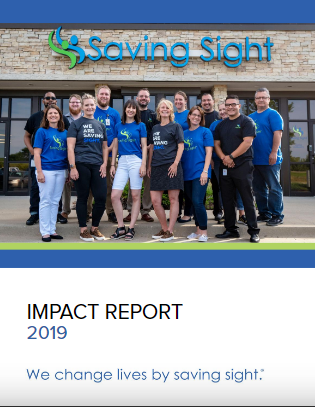
2019 was a record-breaking year, in which Saving Sight provided the gift of sight to even more individuals through the help of our many partners in donation. We’re proud to share our successes with you and humbled to say thank you for your support. We hope that you enjoy hearing the stories of those we’ve served this past year, and that you’ll take the opportunity to share their stories with others, as well.
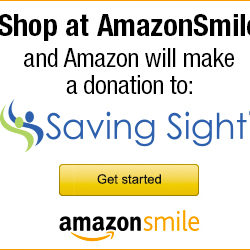
Thanks to AmazonSmile, you can support Saving Sight’s mission to change lives by saving sight when you shop online this holiday season and all year long. Simply shop at 
AmazonSmile features the same products, prices and Amazon Prime member benefits as Amazon.com with one awesome difference: Amazon donates 0.5% of all eligible AmazonSmile purchases to the nonprofit of your choice through the Amazon Smile Foundation. With AmazonSmile you can get the products you need and support Saving Sight’s charitable programs at no additional cost to you.
Follow these 4 simple steps to get involved with Saving Sight’s mission and support our important work through your online shopping.
If you have already completed these steps to set up your AmazonSmile account and designate Saving Sight as your charity of choice, thanks for your support! You will not need to set up your account again. Simply log-in and shop Amazon at smile.amazon.com to direct Amazon Smile Foundation contributions to Saving Sight.
Visit AmazonSmile here to learn more about the AmazonSmile Program.
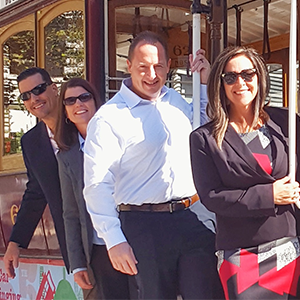
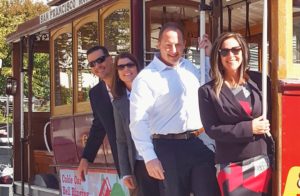
Our Saving Sight Team attends each year to learn about new trends in eye banking and ophthalmology, and to let our partners know innovations we are exploring. Attending also allows us to be a resource to our partners in sharing information to those who couldn’t attend or might have missed part of the meeting. This experience allows us to learn together side-by-side and be a stronger support to our partner surgeons in their work.
In case you missed AAO, or if you want a refresh, here are our top takeaways from the conference and presentations:
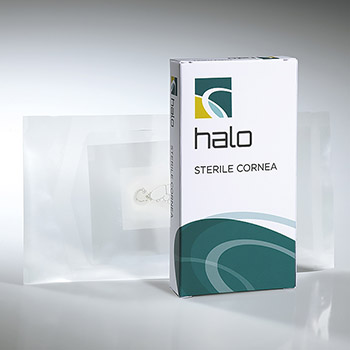
Kansas City, Mo., September 2019 – Saving Sight is proud to offer Halo sterile tissues as another simple and convenient solution for our clinical partners. Halo sterile tissue allografts are currently used by ophthalmic surgeons worldwide as a glaucoma shunt cover, or for cornea surgeries like Keratoplasty, ALKP, DALK, and Boston Keratoprosthesis. The halo cornea is sterile and, as such, has no viable endothelial cells. In addition to the Halo sterile cornea, Saving Sight also offers Halo sterile sclera and sterile pericadium. Both are best suited for surgical use in glaucoma shunt coverage. This allows Saving Sight to provide another service to both cornea surgeons and those who specialize in glaucoma, in addition to continuing our work in recovering, processing and distributing donor tissue for corneal transplantation.
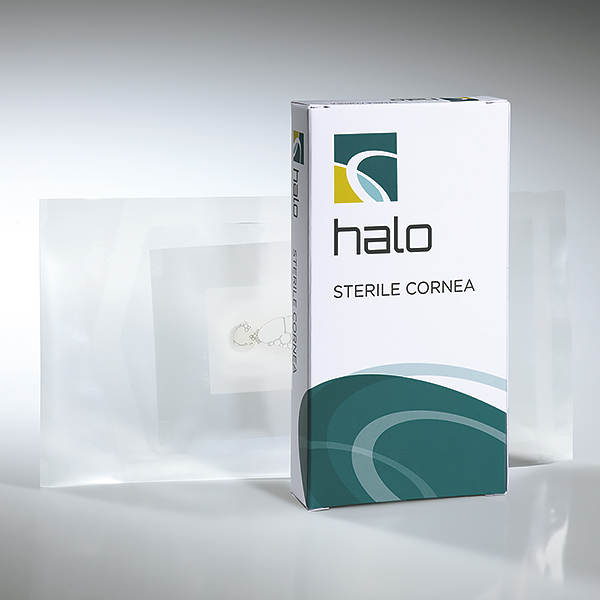
Benefits of Halo Sterile Tissues
Convenience: Tissues feature patented easy-peel packaging for fast and safe introduction to the surgical field.
Clarity: Halo Sterile Cornea is clear and will remain clear, resulting in simplified post-op assessment and improved patient cosmesis.
Shelf Stable: Tissues remain at room temperature and never need reconstitution, so physicians can always have it available in their facility.
Sterility: Halo achieves industry standard sterility by using E-beam Sterilization. The reduced processing time limits environmental exposures.
In addition to offering halo sterile tissues, Saving Sight also offers whole sclera. Please contact our Client Services Team if you have any questions. Learn more at https://saving-sight.org/halo/.
About Saving Sight
Saving Sight is a nonprofit eye bank with a mission to change lives by saving sight. Founded in 1960, Saving Sight has grown to become one of the nation’s leading eye banks and is focused on providing innovative solutions to its clinical and research partners. Saving Sight welcomes customized research collaborations that meet your research tissue needs and strives to advance the field of corneal transplantation through dynamic collaborations with medical centers and researchers. Headquartered in Kansas City, Mo., Saving Sight facilitates eye donation in Missouri, Kansas, and Illinois, serving transplantation and research specialists locally and around the world.
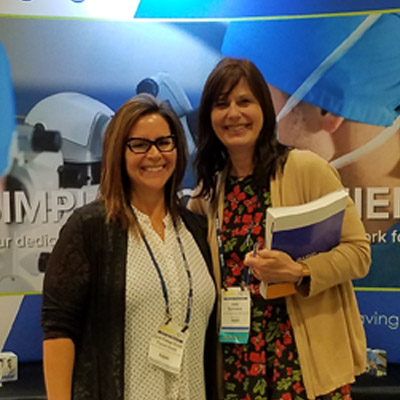
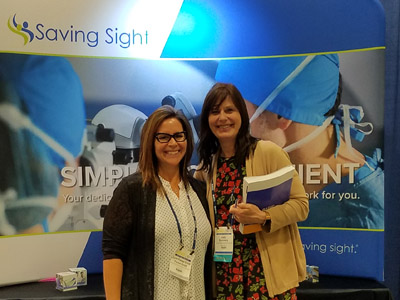
Lynn Forest-Smith, Director of Business Development at Saving Sight, with Dr. Jody Summers at ARVO 2019 in Vancouver.
Kansas City, Mo., August 21, 2019 – Jody Summers, PhD, professor of cell biology at the University of Oklahoma Health Sciences Center, studies the extracellular matrix of the sclera and changes associated with myopia development. Myopia is largely regulated by the visual environment. Through her studies, she hopes to understand why myopia interacts the way it does so intervention is possible.
“Nearly 50 percent of the world’s population will be myopic by 2050,” says Dr. Summers. “In some countries, such as those in East Asia, myopia is the leading cause of blindness. It can be completely preventable with how the eye responds to the visual environment if we can learn why.”
As a postdoctoral fellow in ophthalmology, Dr. Summers identified that there was little research with regard to the sclera. “Through research, I discovered that the sclera is not just a static container in the eye. The sclera is actually very active and can alter its compositions to control the refractive state or length of the eye. What happens in myopia is the sclera begins to elongate. Because sclera is a very responsive tissue, we are trying to understand how sclera remodeling happens so we can work to regulate it – which has taken us to this study.”
Saving Sight was honored to be a co-author on a research project at the 2017 Annual Meeting of the Association for Research in Vision and Ophthalmology (ARVO) with Dr. Summers, titled Isolation and Transcriptome Analyses of Choroidal Retinaldehyde Dehydrogenase-2 (RALDH2) Expressing Cells.
At ARVO 2017, Dr. Summers successfully isolated cells in the choroid (the vascular layer of the eye, located between the sclera and the retina) of both chick and human eyes which have been found to produce the enzyme retinaldehyde dehydrogenase 2 (RALDH2).
“The ARVO abstract was preliminary research to see if we could isolate those cells,” says Dr. Summers. “We first had a pilot study where Saving Sight provided us with two, reduced fee whole globes. This showed we could isolate the retinoic acid in the choroid.”
In summer 2019, Dr. Summers received National Eye Institute at NIH funding to further study the isolated cells through transcriptome analyses. Part of that grant contributes to the fees associated with receiving 10 whole globes or poles (which is the whole eye minus the cornea) from Saving Sight. “This next step is to do it again and do the transcriptome analyses to identify the cells in the choroid that make the retinoic acid.”
Dr. Summers adds that retinoic acid is a powerful chemical and they are interested in identifying the cells that produce it. “If we identify these cell types we can, perhaps, use that information to develop strategy to control the synthesis of retinoic acid,” she says.
Since the human genome has been sequenced, Dr. Summers will be able to sequence the cells from the choroid and compare with the human genome sequence to gather more information as to which cell type is responsible for retinoic acid synthesis.
Collaboration between Researchers and Eye Banks
“I value working with Saving Sight because it was very easy to get the collaboration set up,” says Dr. Summers. “I love that they are interested in research and feel like it’s a two-way relationship. I’m really glad they are available and willing to introduce a new technique or procedure that is compatible for research.”
Dr. Summers adds that one of most valuable connections in eye banks and researchers working together is the ability for Saving Sight to provide human eye tissue for research. “NIH funded research hopes to help humans through the betterment of health. Being able to provide tissue like Saving Sight does under the conditions needed is of value because not many eye banks do that.”
About Saving Sight
Saving Sight is a nonprofit eye bank with a mission to change lives by saving sight. Founded in 1960, Saving Sight has grown to become one of the nation’s leading eye banks and is focused on providing innovative solutions to its clinical and research partners. Saving Sight welcomes customized research collaborations that meet your research tissue needs and strives to advance the field of corneal transplantation through dynamic collaborations with medical centers and researchers. Headquartered in Kansas City, Mo., Saving Sight facilitates eye donation in Missouri, Kansas, and Illinois, serving transplantation and research specialists locally and around the world.
Click here to learn more about Saving Sight’s customized research collaborations.